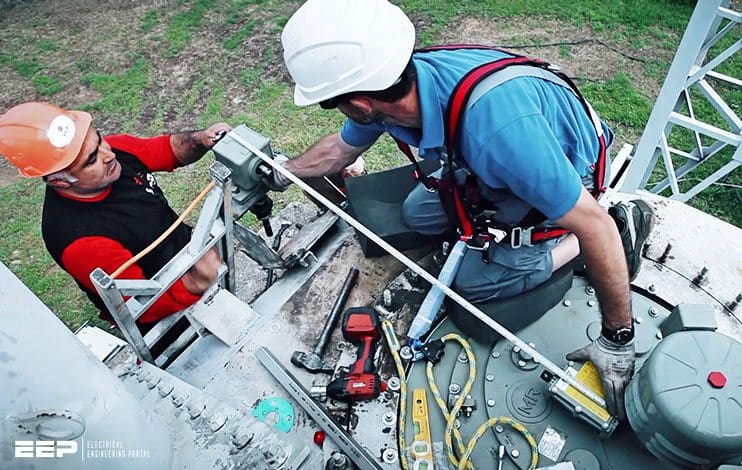Transformer Failure
Failure of transformer in power substation is not a sudden phenomenon, for that matter each and every failure will take place only after alerting through some pre-signs. If they went unnoticed or unattended will result in failure.

Therefore it is wise on the part of the maintenance personnel to act upon the pre failure signs noticed well in advance to keep the transformer failure free and serviceable at all times.
If the new transformer is installed for which there is no past experience, it will be difficult to forecast the defects and probable failures.
- Transformer failure investigation
- Causes of transformer failures and their remedies
- Investigation into causes of failures of transformer
- DO’s & DON’Ts
An approach to transformer failure investigation
1. On Failure Aspects
- Occurrence
- Date of occurrence
- Past similar occurrences if any
- Analysis of failure i.e. why did it happen?
- Whether the rate of failure is worse than other installations?
2. On Maintenance Aspects
- Whether scheduled maintenance and required testing have been carried out on the failed equipment as per norms stipulated?
- Does the frequency of maintenance require change?
- Was the work properly supervised?
- Is any modification possible to avoid failure?
3. About Staff
- Is the quality of work done satisfactorily?
- Is the skilled staff properly trained to carry out the work?
- Are proper tools available with the staff?
4. About Material
- Is the material received from approved source?
- Whether the material is as per approved specification?
- Can a better material be used?
5. About Testing
- Is the testing equipment available?
- Could testing procedure be improved to weed out the failures?
- Whether testing equipment are calibrated?
6. General Points
Whether following points were checked / performed properly?
- Proper contact
- Clearances
- Capacity
- Proper contact pressure
- Crack detections
- Cleaning
- Proper connections / alignment
- Cross checks / super checks
Causes of failures and their remedies
Common Failures of Transformer
Some of the common failures/ defects occurred in transformer are as under:
1. Oil leakage
| Location | Possible Causes | Remedial Action |
| From screw joints | Foreign material in threads | Remove the foreign material |
| Poor threads | Check the threads & replace if required | |
| Improper assembly | Ensure proper assembly | |
| From gasket joints | Insufficient or uneven compression | Tight gasket joints uniformly |
| Improper preparation of gaskets and gasket surfaces | Provide proper gaskets | |
| Old gaskets | Provide new gaskets | |
| From weld joints | Shipping strains, imperfect weld | Repair welds following proper procedure |
| From couplings & their joints | Cracks in couplings | Replace couplings and secure the pipe lines near couplings properly |
| Defective coupling joints | Make proper couplings joints and tight screws | |
| From drain plugs | Defective thread portion | Check the threaded portion |
| Defective oil seal | Replace the oil seal and tight the drain plug |
2. Low break down voltage (BDV)
| Type of Failure | Possible Causes | Remedial Action |
| Low BDV | Moisture contamination in transformer oil due to inactive silica gel (pink color) | Reactivate silica gel crystals or replace them. Purify the transformer oil to restore dielectric strength |
| Leaks around cover accessories, breathing air from leaks | Attend leaks, replace gasket if necessary. Purify the transformer oil to restore dielectric strength | |
| Humid atmosphere in rainy season | Purify the transformer oil to restore dielectric strength and check the BDV & water content |
3. Bushing failure
| Types of Failure | Possible Causes | Remedial Action |
| HV Bushing flashover | Lightning discharge or overvoltage | It may be a break in the turns or end lead, flash marks on the end coil and earthed parts close to it |
| Dirty bushing | Ensure cleaning of porcelain bushing during each inspection | |
| HV Bushing porcelain insulator petticoat broken / cracked | External hitting | Ensure proper cleaning and visual checking of porcelain bushing during each inspection |
4. Winding failures
| Types of Failure | Possible Causes | Remedial Action |
| Primary winding lead open circuited / earthed | Due to overload or brazing failure | Check the winding in one or all phases would show signs of overheating and charring |
| Bulging and inter turn short, inter layer short or inter coils short | Coils shrink and in between insulation failure | Investigate for overloading and take corrective action accordingly |
| Shorting between LV and HV coils | Insulation failure | During manufacturing / rewinding of the transformer, the coils should be pressed down, heated and cooled repeatedly until the coil height stabilizes |
| Flash mark on the core and support | Dead short circuit due to lateral or displacement of the coil | Nomex paper insulation sheet should be provided between H.V. and L.V. coils so as to strengthen the insulation level. Ensure that this insulation sheet does not cause any obstruction in the passage of oil flow |
| Winding loose on the core | Replace the transformer and core to be lifted for thoroughly checking and take corrective action accordingly | |
| Repair the winding if possible |
5. Excessive overheating of oil
| Type of Failure | Possible Causes | Remedial Action |
| Temperature rise of transformer oil | Any internal fault such as short circuited core, core bolts/ clamps insulation failure etc. | Replace the transformer and core to be lifted for thoroughly checking. Take corrective action according to observations and oil test report. |
| Low oil level in conservator | Check the oil level in conservator and top up if required | |
| Slugged oil | Carry out purification of oil to remove sludge | |
| Overloading | Adjust the load |
6. Low IR value
| Type of Failure | Possible Causes | Remedial Action |
| Low IR Value | Moisture in oil | Purify the oil with high vacuum type oil purification plant and test the oil for electrical strength and water content |
| Insulation failure between winding and core | Replace the transformer. Lift the active part and check the winding thoroughly for insulation damage and take corrective action accordingly. | |
| Internal connection leads insulation damage | Check the internal connection leads by lifting the active part and re-tape insulation paper of damaged portion | |
| Weak brazing | Clean the joint and braze properly |
7. Humming sound
| Type of Failure | Possible Causes | Remedial Action |
| Humming sound | Loose core | Lift the active part and tight all the pressure bolts and clamping bolts. |
| Winding loose due to shrinkage of coils | During manufacturing/ rewinding of the transformer, the coils should be pressed down, heated and cooled repeatedly until the coil height stabilizes. | |
| The winding pressure bolts and core clamping bolts should be tightened during the first periodical overhauling after commissioning to take care of shrinkage. |
Investigation into causes of failures of transformer
In most cases the causes of the fault can be surmised by careful observation of the condition of windings, e.g. displacement of the turns or coils, coil insulation (brittle or healthy), evidence of overheating, carbon deposit or flash marks on the core, supports, the inner surface of the tank or cover.
The following notes may be helpful in identifying the causes:
1. Failure due to Lightning Discharge or Overvoltages
This is characterized by break down of the end turns close to the line terminal. There may be a break in the turns or end lead, and also flash marks on the end coil and earthed parts close to it, but the rest of the coils will be found to be healthy.
2. Sustain Overloads
The windings in one or all phases would show signs of overheating and charring. The insulation would be very brittle and would have lost all its elasticity.
3. Inter-turn short, Inter-layer short, or Inter coils short
The same signs as for indicated for sustained overload would be noticed, but only on affected coils, the rest of the coils being intact.
This is likely if the differential relay or the Buchholz relay has operated.
4. Dead Short-circuit
This can be identified by the unmistakable, lateral or axial displacement of the coils. The coils may be loose on the core, some turns on the outermost layer may have burst outwards and broken as if under tension.
If, in addition to these signs, the windings are also completely charred, it is conclusive evidence that the short circuit has continued for an appreciable period, not having been cleared quickly by the protective relays.
5. Buchholz Relay Tripping
If the upper chamber of the Buchholz relay alone has tripped, check the insulation of core bolts, by applying a voltage of 230V to 1000V between the core and each bolt. If it fails, renew the insulating bush.
Observe also all the joints, and tap-changer contacts, for overheating and arcing.
6. Internal Flashover
If the oil shows a low break down voltage (BDV), it does not necessarily mean it has caused the breakdown. At high voltage ratings, excessive moisture content in the oil may result an internal flashover between the live parts and earth, which all leave corresponding tell tale marks.
DO’s & DON’Ts
Do’ s
- Ensure all safety arrangement while working on electrical installation. Ensure that all tools and tackles are in good and working condition.
- Check and thoroughly investigate the transformer whenever any alarm or protection is operated.
- Check the protection system periodically.
- Ensure every employee is familiar with the instructions for restoration of persons suffering from electric shock.
- Trained the staff in operating the fire-fighting equipment.Always avoid unbalance loading on phase!
- Do earthing of all points before starting maintenance.
- Keep all spares away from dirt.
- Work with full confidence.
- Ensure thorough and full cleaning of insulators, since partial cleaning is worse than no cleaning.
- Ensure perfect isolation of supply before commencement of maintenance work. Put a caution board when on work.
Don’ts
- Don’t use low capacity lifting jacks on transformer.
- Don’t leave circuit tap switch unlock.
- Don’t leave any loose connection.
- Don’t meddle with protection system.
- Don’t allow conservator oil level to fall below minimum level mark of indicator.
- Don’t parallel transformers which do not full fill the necessary requirement.
- Don’t allow unauthorised entry in the sub-station.
- Don’t overload the transformer other than the specified limit mentioned.
- Don’t tight the nuts & bolts in excess to arrest any leakage.
- Don’t avoid any unusual noise / occurrence noticed in the substation.
- Never use fuses higher than the prescribed ratings on HV and LV sides.
- Earthing connections should never be done in loose manner.Simply twisting of galvanized iron (GI) wires would be dangerous! The earthing connections should as far as possible be done by using continuous wire or providing suitable connectors. It should be ensured that these connections are tightened rigid.
- Never keep the breather pipe open or exposed.
- Don’t ignore safety rules during maintenance work.
Reference // Maintenance of general services substation by Camtech











thanks alot of information keren
If the transformer is producing low voltage drop, what are the things needed to be done to have normal voltage again. Thanks
Hi please contact me or please provide me with your contact details.
You are the best